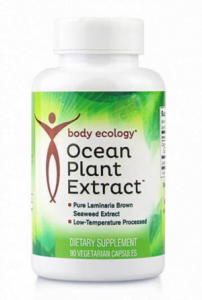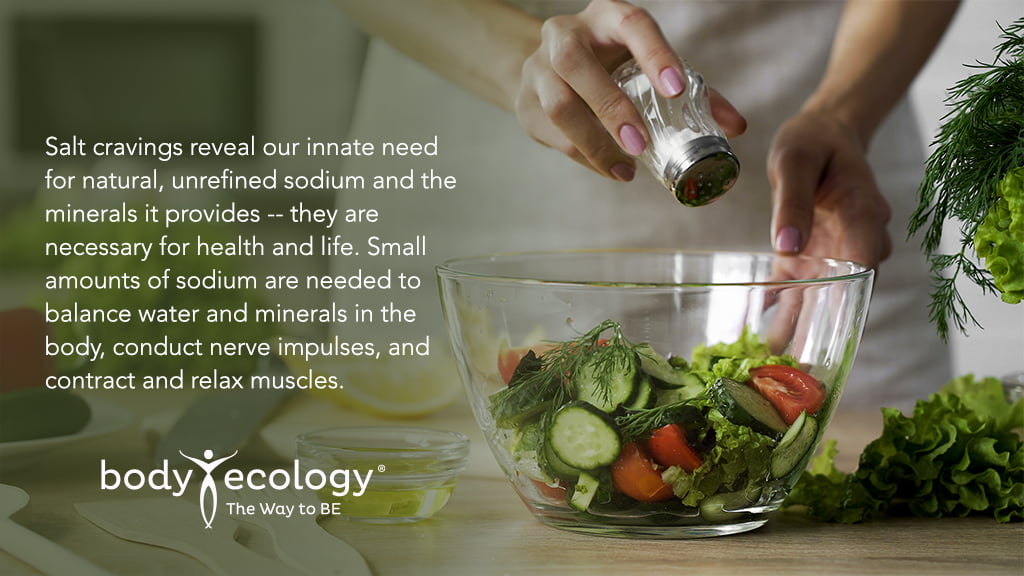Is Sodium Bad For You? What You Don’t Know Can Harm You

Do you usually reach for the salt shaker at the dinner table? Do you find that you crave salty snacks?
If you crave salt, it may be a sign that your body needs minerals. Standard table salt, however, won’t provide those minerals and in fact, it could be a delicious poison.
Here’s what you may not know about salt, and what to reach for instead.
The Problem With Iodized Salt
Regular table salt, or iodized salt, undergoes a refining process that strips it of 60 trace minerals, leaving a nutrient-free flavoring agent. It is highly refined and has additives like sugar, chemicals, and preservatives. Many of the preservatives are not required to be listed on the container and include ferrocyanide, magnesium carbonate, and aluminum hydroxide.
These extra ingredients improve the texture and pour-ability of standard salt, but they are certainly not meant for human consumption. In fact, high levels of aluminum have been found to be a major factor in the prevalence of Alzheimer’s.
Manufacturers put this refined salt into almost every prepared food, and it’s even present in municipal water sources.

We know that too much sodium can cause health problems, such as cardiovascular disease, chronic kidney disease, osteoporosis, and even some cancers. And table salt has the highest amount of sodium per teaspoon — with none of the beneficial nutrients that our bodies desperately need when we ‘crave’ salt.
Real Sodium and Real Minerals
By contrast, natural sea salt is taken from the ocean, where it forms in concentrated amounts. It has no added chemicals, preservatives or sugar. It contains necessary sodium, along with plenty of trace minerals, such as magnesium, potassium, calcium, zinc, and many others.

Keep in mind that natural sea salt does not have high levels of iodine, which are necessary for thyroid function. Since the 1980s, table salt manufacturers have been adding iodine to their refined salt to combat iodine deficiency. However, the health risks of consuming table salt, which is otherwise void of nutrients, simply aren’t worth it.
 Instead, the Body Ecology program encourages eating ocean vegetables, like seaweed and kelp, which are rich in natural iodine to help meet your iodine requirements. If ocean veggies don’t appeal to you, you can also get iodine and minerals, such as calcium, magnesium, iron, manganese, and selenium, from Body Ecology’s Ocean Plant Extract supplement.
Instead, the Body Ecology program encourages eating ocean vegetables, like seaweed and kelp, which are rich in natural iodine to help meet your iodine requirements. If ocean veggies don’t appeal to you, you can also get iodine and minerals, such as calcium, magnesium, iron, manganese, and selenium, from Body Ecology’s Ocean Plant Extract supplement.
The Need for Salt
Salt cravings reveal our innate need for natural, unrefined sodium and the minerals it provides — they are necessary for health and life. Small amounts of sodium are needed to balance water and minerals in the body, conduct nerve impulses, and contract and relax muscles.

Craving salt is a sign that your adrenals, the small glands above your kidneys that regulate sleep, hormones and your body’s response to stress, need some TLC.
Instead of reaching for a bag of salty chips with processed table salt, feed your adrenals—and all your organs—with a daily dose of dark green leafy vegetables, ocean vegetables and vitamins and minerals found in many whole foods. Fermented foods supply beneficial microflora that extracts the vitamins and minerals from these foods, so be sure to include them in at least two main meals daily.
Super Spirulina Plus and Vitality SuperGreen are two great mineral-rich foods. You can add them to your smoothie or protein shake. (We’ve had customers tell us that when they add Super Spirulina Plus to the Probiotic Protein Shake, it tastes like they’ve added chocolate.) You can also try this recipe for a delicious and easy morning smoothie.
How Much Salt Do You Need?
Experts recommend between 1600 mg and 2400 mg of sodium per day for adults, as a general guideline (1 teaspoon of salt provides about 2,000 mg of sodium).
At Body Ecology, we say to follow your own intuition and cravings as long as you use only high-quality, mineral-rich sea salt to satisfy your salt needs. Listen to your body, and you’ll take in the amount you need as your body seeks balance. In the winter, you will naturally want more salt in your food and in the heat of summer, very little to none.
Speaking of balance, if you like to drink a cold, sweet soda with your salty popcorn at the movies, you’ve experienced firsthand how salt, which is contractive and dehydrating, makes you crave expansive sweets. So if you crave sweets, it could be a sign of consuming too much salt. A balanced diet will reduce these cravings.
Especially for women, pay attention to salt intake as you follow your monthly menstrual cycle. Cut way back on salt after ovulation so that your body will naturally become more expansive. It will then relax so that the lining of the uterus will be easily released as nature intended each month. If you eat too much salt during your period, it will inhibit the release of the lining that must be shed, and you will not have a complete cleansing.
After the lining is shed, you can then increase your use of sea salt a bit to bring on a smooth ovulation. The salt helps your ovaries contract to release the egg.
Also, some people are very sensitive to sodium, while others (especially endurance athletes) need more salt to function. In general, men need more than women, and children need the least of all. In some cultures, salt is not given to children until they are two years old. It is believed that too much salt for children will prevent them from growing in height.
While too much of anything can cause health problems, follow the Body Ecology Principle of Balance when it comes to your sea salt intake.
Choose Sea Salt Instead
How much salt you choose is just as important as what kind you choose. Natural sea salt is a much healthier alternative to standard table salt, and can actually improve your health.
It seems like salt has the magic ability to bring out the flavor you were hoping for in the recipe. Recipes just aren’t delicious without the right amount of salt. So simply add natural sea salt to your home-cooked meals. Unfortunately, when eating out, it’s almost impossible to get good quality salt.
We recommend Celtic Sea Salt®, it is widely regarded as one of the healthiest sea salts available. Using natural cultivation methods passed down from generations, salt farmers stir the ocean water until crystals form. Once harvested, Celtic Sea Salt® is moist and biologically active.
Less than 1% of the world’s salt harvest has the artisanal quality of Celtic Sea Salt®. It provides a unique array of bioavailable trace elements that exist in a perfectly balanced matrix. Selina Naturally is located in Asheville, North Carolina and supplies Celtic Sea Salt® to many stores, so it’s very easy to obtain. You can also purchase it on Amazon. By going to their website (www.selinanaturally.com), you’ll find other delicious sea salts from around the world, including Makai Salt from the deep waters of Hawaii. It’s Donna’s favorite.
If you are a fan of Himalayan salt and are fascinated by its pretty pink color, you need to know that it’s mostly mined in Pakistan and exported in bulk, where it is processed in other countries for the consumer market. If you want a really clean, delicious-tasting Himalayan salt you can also find it at www.SelinaNaturally.com.
Special for YOU! They’re giving our audience 20% off with the coupon code BED20 on their 5-star rated Celtic Sea Salt bundle that contains many of their top sellers to include in a healthy kitchen.
By listening to your body and choosing only high-quality sea salt, you’ll enjoy the health rewards of sodium and minerals—while avoiding the damage caused by ordinary table salt— AND your taste buds will thank you!









